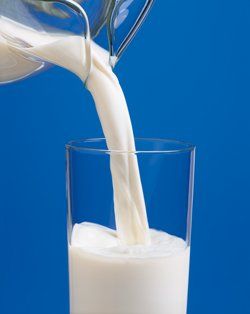Surprise, Surprise: Dairy Products May Promote Weight Loss
Dieters hoping to lose pounds may find help in a milk bottle rather than a pill bottle, according to research from the University of Tennessee Nutrition Institute (Knoxville, TN) and other sources.

Some researchers believe dairy products may control hunger pains and reduce overall body fat.
Photo courtesy of the National Dairy Council.
Dieters hoping to lose pounds may find help in a milk bottle rather than a pill bottle, according to research from the University of Tennessee Nutrition Institute (Knoxville, TN) and other sources. Findings are preliminary, but some researchers believe dairy products may control hunger pains and reduce overall body fat. What's more, diets combining dairy products and calorie reduction appear to reduce body fat more effectively than diets that reduce calories alone.
The research flies in the face of current perceptions about dairy products. Consumers link dairy with calcium, not weight management. Also, consumers tend to think dairy is high in fat. A HealthFocus (Des Moines, IA) survey of 2000 people found 9% avoided dairy products principally because of the fat content.
Emerging research may turn these perceptions upside down. Dairy products may help control body weight via satiety perception. 'Satiety, among other things, has been linked to foods that stimulate release of a small protein-based hormone called cholecystokinin (CCK) into the bloodstream,' explains Jill Rippe, director of R&D at Main Street Ingredients (LaCrosse, WI). 'CCK tells your brain that your stomach is full. Whey proteins in particular contain glycomacropeptide (GMP), which acts as a CCK stimulator.'
'Much of the research of late has focused on the effects of various proteins from various sources to affect the production of gastrointestinal hormones such as insulin and glucagon and/or peptides such as CCK, glucagon-like peptide-1 (GLP-1), and insulinotropic polypeptide,' says Amy McDonald, vice president of Kerry Bio-Science Americas (Hoffman Estates, IL). 'These compounds have been shown to help induce a sense of satiety. Other proteins are more slowly digested and as result also produce a lingering satiety.'
Dairy products may also interact with the body's fat-storing mechanism. Michael Zemel, PhD, a professor at the University of Tennessee Nutrition Institute, suggests that a hormone called calcitriol is critical to fat metabolism. He postulates than when calcium levels are low, calcitriol triggers a starvation response, telling the body to store fat. Zemel also believes that calcium increases fat metabolism, thereby accelerating weight loss.

Dairy products such as yogurt may also help in the battle against excess trans fat consumption.
Photo courtesy of the National Dairy Council.
Zemel's latest calcium study appeared in the May 2004 edition of the American Journal of Clinical Nutrition. He confirmed that low-calcium diets stimulate calcitriol production, in turn stimulating adiposity. On the other end of the spectrum, he found high-calcium diets help regulate fat and weight gain in energy-dense diets by inhibiting lipogenesis and promoting lipolysis, lipid oxidation, and thermogenesis.
'Notably, dairy sources of calcium markedly attenuate weight and fat gain and accelerate fat loss to a greater degree than supplemental sources of calcium,' wrote Zemel.
According to Zemel, the augmented effect of dairy products relative to supplemental calcium is likely due to the presence of additional bioactive compounds, including angiotensin-converting enzyme inhibitors and branched-chain amino acids in whey, which work together with calcium to attenuate adiposity.
Rippe says the recommendation is to consume at least 1000 mg of calcium per day from dairy sources, with optimally 1200-1600 mg total calcium per day spread out over 3-4 servings.
Whey Protein Crisps Offer Protein in a Crunch
LOMIRA, WI-A new protein crisp derived from dairy ingredients provides an alternative to soy, corn, and rice-based crunchy ingredients.
Grande Custom Ingredients' WPCrisp is made from extruded whey protein, which delivers protein along with a clean dairy flavor. WPCrisp is available in four standard sizes at 50% protein but can be customized to meet specific requirements.
According to Steve Dott, vice president of Grande Custom Ingredients Group, WPCrisp was developed in conjunction with Dairy Management Inc. (Rosemont, IL) and researchers from Utah State University (USU; Logan, UT). Grande has licensed exclusive rights to a USU patent to manufacture and market the product.
'It was very important for us to hold the patent on the process and the product,' says Dott. 'When our customers use WPCrisp, it's critical that they can depend on consistent quality and performance, and the patent helps us guarantee that.'
'I predict that we will have more conclusive information on this in the near future as more studies are under way on this hot topic,' says Rippe. 'Greater attention must be paid to the types and amounts of foods that children and adults eat.'
Dairy proteins, in a high-calcium form, may prove to be winning weight-regulation contributors of nutritional quality, satiety, and metabolic fat regulation.
'There is an excellent variety of health-oriented ingredients available to design products to exacting dietary profiles,' says Rippe. 'Whey protein isolate is an ideal protein source to use due to its excellent nutritional properties and digestibility, GMP content, clean flavor profile, versatile functionality, and ability to be used by lactose-intolerant individuals.'
Also, dairy calcium can be concentrated in powders called milk minerals or whey minerals complex. 'This is an excellent bioavailable source of both calcium and phosphorus that also includes magnesium, potassium, zinc, copper, and iron,' says Rippe.
LESS TRANS FAT
Dairy products may also help in the battle against excess trans fat consumption. By January 1, 2006, all products with more than 0.5 g of trans fat per serving will be required by law to list trans fat content on the label. Food manufacturers already have begun requesting trans fatty acid (TFA) information, according to Dairy Management Inc. (Rosemont, IL).
Whey can help keep trans fats off the label. 'Dairy ingredients are naturally very low in trans fat,' says Sharon Gerdes, technical support consultant for Dairy Management Inc. 'In addition, whey proteins can replace some of the fat in food formulations, thus reducing the level of trans fats.'
Whey proteins perform emulsification, texture modification, and other fat functions. 'For example, in a pie crust, whey at 2-3% of flour weight can aid in emulsifying the shortening,' says Gerdes. 'Bakers can reduce the shortening and still produce a tender, flaky crust.'
The extent that whey proteins mimic fats depends on the properties of the whey. 'Whey protein isolates (WPI) and 80% whey protein concentrates (WPC80) have higher levels of protein, allowing more of the functions of fats in food systems,' says Gerdes. 'Whey phospholipids are a new dairy ingredient that has even greater emulsification power. 'Whey phospholipids work well in frozen dairy desserts, baked goods, cheese sauces, and aerosol sprays.'
Dutch Olympic Team Benefits from DSM Sports Drink
HEERLEN, THE NETHERLANDS-Dutch athletes participating in the summer Olympics are hoping a new protein drink from DSM will boost their performance in the games.
PeptoPro uses small dairy peptides to accelerate the replenishment of energy in muscle tissue after exercise.
In a study by the University of Maastricht's nutrition and toxicology research unit, PeptoPro was found to improve average performance levels in athletes by 5% compared with athletes who drank conventional sports drinks, according to DSM.
The drink has been a hit among Dutch athletes. On August 9, DSM announced that it had delivered 200,000 cartons to the nearly 300 Dutch Olympic competitors, with 10,000 cartons delivered to the team's village in Athens.
Whey can also improve flavor and color. 'Whey proteins are bland and work well in a variety of food applications. In beverages, puddings, sauces, and baked goods, they impart a sweet dairy note which rounds and works well with other flavors. It is usually not necessary to mask whey flavors.'
A rough estimate of the level of trans fat in the milkfat of a dairy product or ingredient can be found by multiplying the level of milkfat in 100 g of product by the estimated level of TFA in milkfat.
For example, whole milk has 3.25 g of milkfat per 100 g. Multiplying by the estimated level of TFA-3.3%-results in 0.11 g of TFA per 100 g of milk. A cup serving of whole milk is 244 g. Thus the amount of TFA in one serving is 0.11 X 2.44, or approximately 0.3 g of TFA per serving. Since 0.3 g is under the 0.5 g trans fat threshold, the label could read 0 g of trans fat.

Whole milk has 3.25 g of milkfat and 0.11 g of trans fatty acids per 100 g.
Photo courtesy of the National Dairy Council.
In addition to trans fats, dairy proteins can be substituted for carbohydrates to keep carb consumption within healthy limits. 'The industry trend to decrease carbohydrate intake has impacted everyone associated with the food industry,' says Kerry's McDonald. 'But formulating products with reduced carbohydrate content, that is, increased protein, often results in foods with altered textural attributes that may change negatively over the shelf life of the product. Kerry Ingredients Ireland has several virtually carb-free proteins that minimize and/or eliminate many of the product-development issues associated with higher-protein formulations.'
Dairy isn't the only protein that can replace carbohydrates, but dairy might be more efficient at controlling glycemic response than other protein sources, according to a study from the Clinical Research Unit of CSIRO Health Sciences and Nutrition (Adelaide, Australia).
Fifty obese adults followed isocaloric diets high in dairy or mixed protein. Throughout the study, measures were taken of body composition, glycemic control, serum lipids, blood pressure, and markers of vascular and liver function.
The protein source had no effect on net weight loss or body composition. However, glycemic response was 30% lower in subjects on the dairy protein diet. Both diets resulted in improvements in cardiovascular risk markers and liver function. Neither protein source nor dietary calcium significantly affected weight loss or body composition.
The study is far too small to be conclusive, but the results deserve further investigation. In any event, current research indicates that dairy has more benefits than just calcium. In the future, 'Got Milk?' may not only be the slogan for healthy bones and teeth, but the next generation of dieters.
Judge denies CRN’s motion for preliminary injunction but its lawsuit against NY state will proceed
April 23rd 2024The judge in CRN's lawsuit against NY state's law banning the sale of weight management and muscle building supplements to minors has denied its motion for a preliminary injunction, but determined that CRN has standing to sue on behalf of its members.
CRN NY State lawsuit update: Dispatch from SupplySide East 2024
April 18th 2024CRN's Steve Mister updates Nutritional Outlook about its ongoing litigation against NY State. The organization sued the state to prevent the enforcement of law that bans sale of weight management supplements to minors.
Microalgae extract supports metabolic health and bone mass during diet and exercise routine
April 11th 2024The extract from Microphyt, called PhaeOptim, was shown to complement weight management strategies that include diet and exercise by support bone mass, aerobic capacity, resting heart rate, and blood lipid profiles.